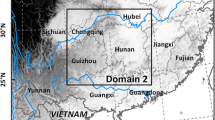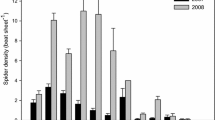Abstract
We analyzed overseas immigrations of rice planthoppers in Kyushu, Japan, based on trap data collected during June–July in 2000–2011. The immigrant density was high in 2006, whereas it was low in 2008 and 2011. To understand these annual fluctuations, we investigated the relationships among trap catches and the following three meteorological conditions: (1) the average temperature during January–February in North Vietnam (T NV), where planthoppers successfully overwinter; (2) the strong upper wind from North Vietnam to South China in April–May (UWVC), when the first stage of migration occurs; (3) the strong upper wind from South China to Kyushu in June–July (UWCJ), when the second stage of migration occurs. In 2008 and 2011, T NV values were 2.4–3.0 °C below the 2000–2011 average of 17.4 °C, and there were 9–13 fewer days with a strong upper wind (UWVC + UWCJ) in April–July compared with the 2000–2011 average of 25 days. This study showed that the rice planthopper immigrant density during the last 12 years correlated significantly with T NV and the number of days with a strong upper wind (UWVC + UWCJ) in April–July. Thus, the meteorological conditions affected the immigrant density of rice planthoppers in Kyushu.



Similar content being viewed by others
References
Cheng J (2009) Rice planthopper problems and relevant causes in China. In: Heong KL, Hardy B (eds) Planthoppers: new threats to the sustainability of intensive rice production systems in Asia. International Rice Research Institute, Los Baños, pp 157–178
Cheng S, Chen J, Si H, Yan L, Chu T, Wu C, Chien J, Yan C (1979) Studies on the migration of brown planthopper Nilaparvata lugens Stål. Acta Entomol Sinica 22:1–21 (in Chinese with English summary)
Guangdong Plant Protection General Station (2012) Website (in Chinese). http://www.gdzbz.com. Accessed 10 March 2012
Guangxi Plant Protection General Station (2012) Website (in Chinese). http://www.gxzb.com. Accessed 10 March 2012
Harris R (2006) Monitoring of neonicotinoid resistance in Nilaparvata lugens and subsequent management strategies in Asia Pacific. In: Proc Int Workshop on Ecology and Management of Rice Planthoppers, 16–19 May 2006, Hangzhou, China, p 2
Hu G, Xie MC, Lin ZX, Xin DY, Huang CY, Chen W, Zhang XX, Zhai BP (2010) Are outbreaks of Nilaparvata lugens (Stål) associated with global warming? Environ Entomol 39:1705–1714
Japan Meteorological Agency (2012) El Niño/La Niña event (in Japanese). http://www.data.jma.go.jp/gmd/cpd/elnino/index.html. Accessed 10 March 2012
Japanese Study Group for Climate Impact and Application (2011) El Niño/La Niña event: impact upon global environment and human society. Seizando-shoten, Tokyo, p 253 (in Japanese)
Kisimoto R (1975) Transoceanic migration of planthoppers. Chuokoron, Tokyo, p 233 (in Japanese)
Kisimoto R (1976) Synoptic weather conditions inducing long-distance immigration of planthoppers, Sogatella furcifera Horváth and Nilaparvata lugens Stål. Ecol Entomol 1:95–109
Kistler R, Kalnay E, Collins W, Saha S, White G, Woollen J, Chelliah M, Ebisuzaki W, Kanamitu M, Kousky V, van den Dool H, Jenne R, Fiorino M (2001) The NCEP-NCAR 50-year reanalysis: monthly means (CD-ROM and documentation). Bull Am Meteorol Soc 82:247–268
Kitoh A, Uchiyama T (2006) Changes in onset and withdrawal of the East Asian summer rainy season by multi-model global warming experiments. J Meteorol Soc Jpn 84:247–258
Matsumura M (2009) Current status of insecticide resistance in Asian planthoppers. Plant Prot 63:745–748 (in Japanese)
Matsumura M, Sakai J (2011) Occurrence of a new disease caused by southern rice black-streaked dwarf virus transmitted by the whitebacked planthoppers. Plant Prot 65:244–246 (in Japanese)
Matsumura M, Takeuchi H, Satoh M, Sanada-Morimura S, Otuka A, Watanabe T, Dinh VT (2008) Species-specific insecticide resistance to imidacloprid and fipronil in the rice planthoppers Nilaparvata lugens and Sogatella furcifera in East and South-east Asia. Pest Manage Sci 64:1115–1121
Morishita M (1992) A possible relationship between outbreaks of planthoppers, Nilaparvata lugens Stål and Sogatella furcifera Horváth (Hemiptera: Delphacidae) in Japan and the El Niño phenomenon. Appl Entomol Zool 27:297–299
National Coordinated Research Group for White-Backed Planthopper (1981) Studies on the migration of white-backed planthopper (Sogatella furcifera Horváth). Scientia Agric Sinica 5:25–31 (in Chinese with English summary)
Otuka A, Dudhia J, Watanabe T, Furuno A (2005a) A new trajectory analysis method for migratory planthoppers, Sogatella furcifera (Horváth) (Homoptera: Delphacidae) and Nilaparvata lugens (Stål), using an advanced weather forecast model. Agri Forest Ent 7:1–9
Otuka A, Watanabe T, Suzuki Y, Matsumura M, Furuno A, Chino M (2005b) Real-time prediction system for migration of rice planthoppers, Sogatella furcifera (Horváth) and Nilaparvata lugens (Stål) (Homoptera: Delphacidae). Appl Entomol Zool 40:221–229
Otuka A, Watanabe T, Suzuki Y, Matsumura M, Furuno A, Chino M, Kondo T, Kamimuro T (2006) A migration analysis of Sogatella furcifera (Horváth) (Homoptera: Delphacidae) using hourly catches and three-dimensional simulation model. Agri Forest Ent 8:35–47
Otuka A, Matsumura M, Watanabe T, Dinh TV (2008) A migration analysis for rice planthoppers, Sogatella furcifera (Horváth) and Nilaparvata lugens (Stål) (Homoptera: Delphacidae), emigrating from northern Vietnam from April to May. Appl Entomol Zool 43:527–534
Sato N, Takahashi M (2001) Long-term variations of the Baiu frontal zone and midsummer weather in Japan. J Meteorol Soc Jpn 79:759–770
Sogawa K (1993a) Source estimation of brown planthopper based upon biotype. Jpn Agric Technol 37(4):36–40 (in Japanese)
Sogawa K (1993b) Biotype variations in the rice brown planthopper and possible source areas of its monsoonic migrants. Plant Prot 48:165–168 (in Japanese)
Sogawa K (1993c) Rice crop cultivation in migration source regions of the rice planthoppers and their occurrence. Jpn Agric Technol 37(7):32–36 (in Japanese)
Sogawa K (1995) Windborn displacements of the rice planthoppers related to the seasonal weather patterns in Kyushu district. Bull Kyusyu Natl Agric Exp Stn 28:219–278
Sogawa K, Watanabe T (1989) Outline of long-term yearly fluctuations of the rice planthoppers occurrence from light-trap data at Kyushu National Agricultural Experiment Station. Proc Assoc Plant Prot Kyushu 35:65–68 (in Japanese)
Sogawa K, Liu GJ, Qiang Q (2009) Prevalence of whitebacked planthoppers in Chinese hybrid rice and whitebacked planthopper resistance in Chinese japonica rice. In: Heong KL, Hardy B (eds) Planthoppers: new threats to the sustainability of intensive rice production systems in Asia. International Rice Research Institute, Los Baños, pp 257–280
Suzuki Y, Wada T (1994) Rice cropping and occurrence of brown planthopper in Vietnam. Plant Prot 48:165–168 (in Japanese)
Watanabe T (1994) Population dynamics of long distance migratory rice planthoppers, Nilaparvata lugens Stål and Sogatella furcifera Horváth, and yield analysis of rice plant infested with these planthoppers (Ph.D. thesis). Kyoto University, Japan, p 193 (in Japanese with English summary)
Watanabe T, Matsumura M, Otuka A (2009) Recent occurrence of long-distance migratory planthoppers and factors causing outbreaks in Japan. In: Heong KL, Hardy B (eds) Planthoppers: new threats to the sustainability of intensive rice production systems in Asia. International Rice Research Institute, Los Baños, pp 179–190
Zhang HM, Yang J, Chen JP, Adams MJ (2008) A black-streaked dwarf disease on rice in China is caused by a novel fijivirus. Arch Virol 153:1893–1898
Zhou GH, Wen JJ, Cai DJ, Li P, Xu DL, Zhang SG (2008) Southern rice black-streaked dwarf virus: a new proposed Fijivirus species in the family Reoviridae. Chin Sci Bull 53:3677–3685
Acknowledgments
We thank the numerous staff of the Prefectural Agricultural Research Centers and Plant Protection Offices located in Nagasaki, Kumamoto, and Saga for kindly supplying trap data for planthoppers in their prefectures.
Author information
Authors and Affiliations
Corresponding author
Appendix
Appendix
-
1.
Relational expression for the first stage of emigrations from North Vietnam to South China during April and May
The total number of planthoppers as the i-th emigrants in North Vietnam can be described using the following relational expression (1), because they are directly proportional to the product of OWVietnam (the number of successfully overwintered planthoppers) and G Vietnam (the population growth rate in North Vietnam, considering the effects of parameters such as temperature and pesticide application):
$$ \mathop \sum \limits_{i} {\text{EM}}_{i}^{{ {\text{Vietnam}}}} \propto {\text{OW}}^{\text{Vietnam}} {G}^{\text{Vietnam}}. $$(1) -
2.
Relational expression for the first stage of immigration into South China from North Vietnam during April and May
The total number of immigrants into major destination regions in the first stage of migration in South China (IMSouth China) can be described using the following relational expression (2), considering the rate of successful long-distance migration and subsequent landing on the ground for the i-th emigration (R 1st migration i ):
$$ {\text{IM}}^{\text{South\;China}} = \mathop \sum \limits_{i} {\text{EM}}_{i}^{{ {\text{Vietnam}}}} R_{i}^{{ 1 {\text{st\;migration}}}}. $$(2) -
3.
Relational expression for the second stage of emigrations from South China to Kyushu during June and July
The total number of planthoppers as the i-th emigrants in South China can be described using the following relational expression (3), because they are directly proportional to the product of IMSouth China and G South China (population growth rate in South China, considering the effects of parameters such as temperature and pesticide application):
$$ \mathop \sum \limits_{i} {\text{EM}}_{i}^{{\text{South\;China}}} \propto {\text{IM}}^{\text{{South\;China}}} G^{{\text{South\;China}}}. $$(3) -
4.
Relational expression for the second stage of immigration into Kyushu from South China during June and July
The total number of immigrants into Kyushu (IMKyushu) can be described using the following relational expression (4), considering the rate of successful transoceanic migration and subsequent landing on the ground in the i-th emigration (R 2nd migration i ):
$$ {\text{IM}}^{\text{Kyushu}} = \mathop \sum \limits_{i} {\text{EM}}_{i}^{\text{South\;China}} R_{i}^{{ 2 {\text{nd\;migration}}}}. $$(4)
Rights and permissions
About this article
Cite this article
Syobu, Si., Otuka, A. & Matsumura, M. Annual fluctuations in the immigrant density of rice planthoppers, Sogatella furcifera and Nilaparvata lugens (Hemiptera: Delphacidae), in the Kyushu district of Japan, and associated meteorological conditions. Appl Entomol Zool 47, 399–412 (2012). https://doi.org/10.1007/s13355-012-0132-8
Received:
Accepted:
Published:
Issue Date:
DOI: https://doi.org/10.1007/s13355-012-0132-8




